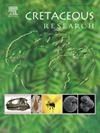白垩纪中期缅甸琥珀中最古老的鞘翅目甲虫 Cretoprostominia myanmarensis gen.
IF 1.9
3区 地球科学
Q1 GEOLOGY
引用次数: 0
摘要
从白垩纪中期的缅甸琥珀中发现了最古老的蝾螈:Cretoprostominia myanmarensis Jiang, Liu and Chen gen.该新属与现存的 Prostominia 属 Reitter, 1889 最为相似,而与后者的不同之处在于其前胸狭长分离。这一新发现丰富了我们对盐肤木科演化史的认识。本文章由计算机程序翻译,如有差异,请以英文原文为准。
Cretoprostominia myanmarensis gen. et sp. n., the oldest salpingid beetle (Coleoptera: Salpingidae) from mid-Cretaceous Myanmar amber
The oldest salpingid beetle is discovered from the mid-Cretaceous Myanmar amber: Cretoprostominia myanmarensis Jiang, Liu and Chen gen. et. sp. nov. The new genus is most similar to the extant genus Prostominia Reitter, 1889 and differs from the latter by the narrowly separated procoxae. The new discovery enriches our knowledge of the evolutionary history of the family Salpingidae.
求助全文
通过发布文献求助,成功后即可免费获取论文全文。
去求助
来源期刊

Cretaceous Research
地学-地质学
CiteScore
4.10
自引率
19.00%
发文量
235
审稿时长
12 weeks
期刊介绍:
Cretaceous Research provides a forum for the rapid publication of research on all aspects of the Cretaceous Period, including its boundaries with the Jurassic and Palaeogene. Authoritative papers reporting detailed investigations of Cretaceous stratigraphy and palaeontology, studies of regional geology, and reviews of recently published books are complemented by short communications of significant new findings.
Papers submitted to Cretaceous Research should place the research in a broad context, with emphasis placed towards our better understanding of the Cretaceous, that are therefore of interest to the diverse, international readership of the journal. Full length papers that focus solely on a local theme or area will not be accepted for publication; authors of short communications are encouraged to discuss how their findings are of relevance to the Cretaceous on a broad scale.
Research Areas include:
• Regional geology
• Stratigraphy and palaeontology
• Palaeobiology
• Palaeobiogeography
• Palaeoceanography
• Palaeoclimatology
• Evolutionary Palaeoecology
• Geochronology
• Global events.
 求助内容:
求助内容: 应助结果提醒方式:
应助结果提醒方式:


